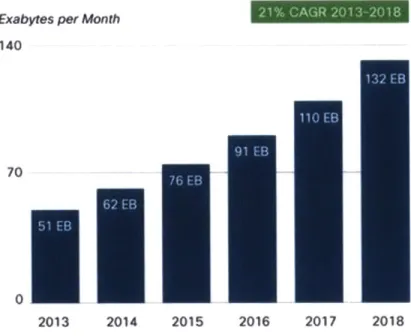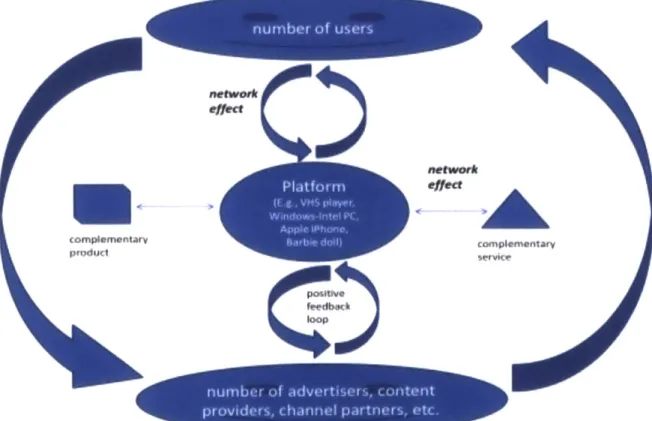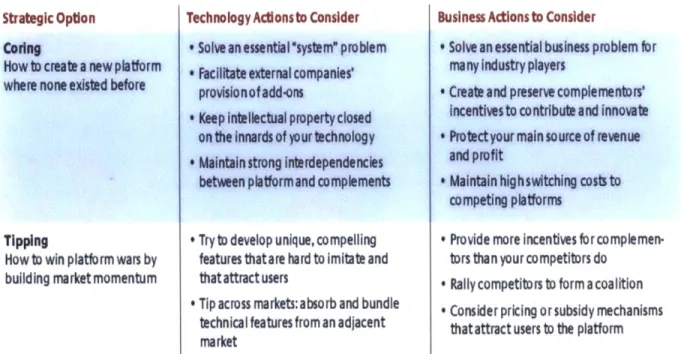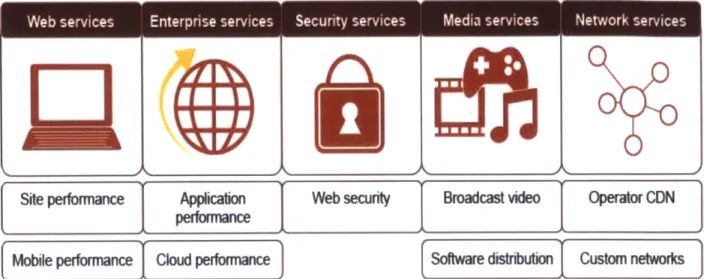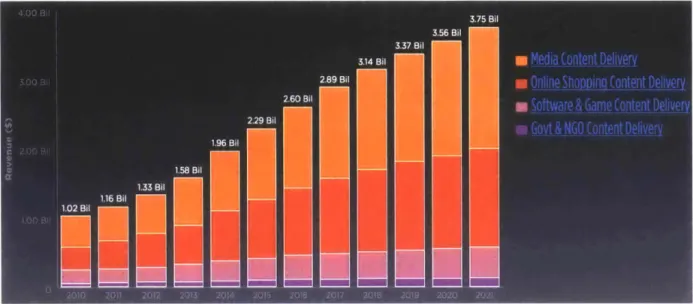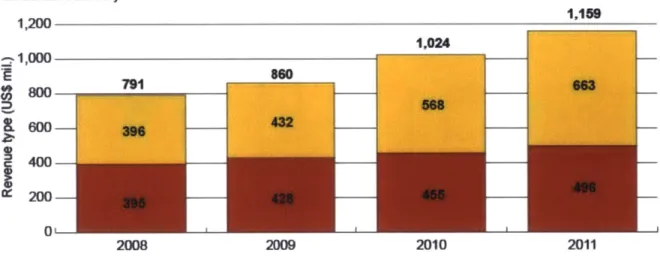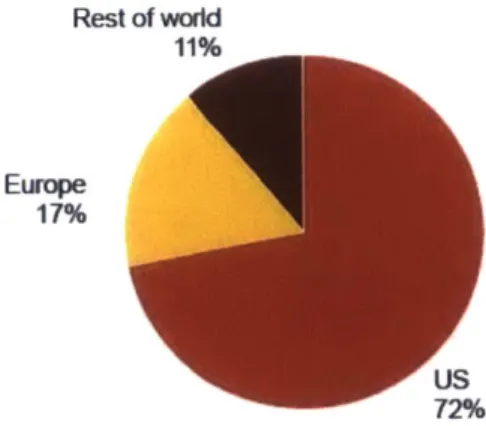Developing a Platform Strategy for Akamai Cloudlet Applications
byMing Jiang
B.S. Computer Science, Huazhong University of Science and Technology, 2004
M.S. Computer Science, Worcester Polytechnic Institute, 2008
SUBMITTED TO THE SYSTEM DESIGN AND MANAGEMENT PROGRAM IN PARTIAL FULFILLMENT OF THE REQUIREMENTS FOR THE DEGREE OF
MASTER OF SCIENCE IN ENGINEERING AND MANAGEMENT AT THE
MASSACHUSETTS INSTITUTE OF TECHNOLOGY
MASSACHU.SETTS INSTITUTE
OF fECHNOLOLGY
AUG 06 2015
LIBRARIES
January 2015
[feb nsC"
2D0IS
@2015 Ming Jiang, All rights reserved
The author hereby grants to MIT the permission to reproduce and to distribute publicly paper and electronic copies of this thesis document in whole or in part in any medium now know or hereafter created
Signature of Author...
Signature redacted
Ming Jiang System Design and Management Program, MIT January 25, 2015
Siqnature redacted
... ...
Michael Cusumano Sloan Management Review Distinguished Professor of Management and Engineering Systems, MIT Thesis Supervisor
Accepted By...
/(i
Le
SignaturE redacted,....
s - r Patrick Hale
Senior Lecturer, Engineering Systems Division, MIT Director, System Design and Management Program
Developing a Platform Strategy for Akamai Cloudlet Applications
byMing Jiang
Submitted to the System Design and Management Program on January 30, 2015 in partial fulfillment of the requirements for the degree of
Master of Science in Engineering and Management
Abstract
Akamai, a high tech company based in Cambridge Massachusetts, is a market leader in global Content Delivery Network (CDN) industry. To fully leverage opportunities and also tackle challenges in market, the company has been keeping innovating new products and
providing new services to keep existing customers while attracting new ones.
One of company's strategic plans is to extend company's current products and services into an industry platform, such that Akamai can leverage other companies' resources to better serve broader customer base to achieve sustainable growth. One product identified by the company that has the potential to be extended into industry platform is called Cloudlet. Cloudlet is a series of new applications launched by Akamai in 2014. Those applications aim to solve business and operational challenges that customers have but do not belong to traditional CDN services.
The research topic of this thesis is to develop platform strategies that could extend Cloudlet into a platform. To achieve this goal, the writer started with reviewing related literatures and identified existing frameworks to conduct systematic analysis on challenges the company may encounter in different aspects. Also, the writer gained first hand experience
by working in Cloudlet product management team and initiated a series of interviews with
different stakeholders inside the company for different perspectives. Also the writer has conducted two case studies regarding successful cloud services to identify best practices that Cloudlet team inside Akamai can leverage. Finally, a list of strategic actions is proposed for Cloudlet platform transformation with analysis on how these actions can best attract customers and motivate stakeholders internally and externally.
Thesis Supervisor: Michael Cusumano
Title: Sloan Management Review Professor of Management and Engineering Systems Department: Massachusetts Institute of Technology, Sloan School of Management
Acknowledgements
I would like to first express my appreciation to Pat Hale during my studies at MIT.
We are so privileged to have someone like you who are always ready to listen to and help all students.
I would like to thank my thesis advisor, Professor Michael A. Cusumano, not only for
your guidance on thesis but also mentorship on software businesses, platform strategy and high tech entrepreneurship.
It is impossible to complete this thesis without supports from the management team of Akamai. The product management internship in Akamai Cloudlet team enabled me to gain first hand experience and conduct research needed for this thesis. The conversation with the management team of Akamai Web Experience Business Unit and broader access to the personnel in different departments helped me better understand the technology and business sides of Akamai. Specifically, I want to thank Maya Bustan, Zoltan Poleretzky and Ravi Maira for their guidance on strategies, challenges and insights of Akamai's business.
I want to express my deepest gratitude to my wife, Yingying Lang. Without her
patience, sacrifices and unconditional support, I would not be able to complete my studies.
A special word of thanks also goes to my family for their continuous support and
encouragement.
The amazing experience at SDM program and MIT community not only equipped me with skills and knowledge for career development but also reshaped my approach to
analyze and solve problems. I will always cherish the memories of past two years. Ming Jiang,
Table of Contents
Chapter 1 - O verview ... 11
1.1 Background ... 11
1.2 M otivations ... 12
1.3 Research Questions and Approach ... 13
1.4 Thesis Roadm ap ... 13
Chapter 2 - Literature Review ... 15
2.1 Softw are Business M odels... 15
2.1.1 Three kinds of business m odels ... 15
2.1.2 Com panies Growth Strategies ... 16
2.1.3 Shifts from Products to Services (as Life-Cycle)... 16
2.2 Platform Strategies... 17
2.2.1 Platform Definitions ... 17
2.2.2 Platform Leadership Analysis Fram ework... 19
2.2.3 Strategies to Grow into a Pla toform Leadership Position ... 21
Chapter 3 - A kam ai Technologies... 23
3.1 Com pany H istory ... 23
3.2 Current Product Portfolios ... .... 23
3.2.1 W eb Services...24 3.2.2 Enterprise Services...25 3.2.3 Security Services ... 25 3.2.4 M edia Services... 26 3.2.5 Network Services ... 26 3.2.6 Su m m a ry ... 26 3.3 M arket Positions... 27 3.3.1 Revenue Analysis... 27 3.3.2 Com petitions ... 29
3.4 New Challenges and Opportunities in Technology... 31
3.4.1 W eb Surfing From M obile Devices... 31
3.4.2 Fragm entation of M obile Devices... 32
3.4.3 Responsive W eb Designs... 35
3.5 New Challenges and Opportunities in Business... 36
3.5.1 Traditional M edia m arket: Decreasing m argin... 36
3.5.2 DevOps: Emerging Demands and Best Practices from Enterprises... 36
3.5.3 Western Europe and Pacific Asia: Increasing market potential Outside US... 37
3.6 Cloudlet...38
3.6.1 Akam ai W eb Experience (W ebEx) Business Unit... 38
3.6.2 Cloudlet: Basic Concepts ... 39
3.6.3 Cloudlet: M otivations and Challenges... 40
Chapter 4 - Cloud Computing Platform Strategy Case Studies ... 42
4.1 Introductions to Amazon Web Services (AWS) and Salesforce... 42
4.1.1 Salesforce ... 42
4.1.2 Am azon A W S... 44
4.1.3 Differences between the two platform s... 46
4.2.1 Salesfrorce ... 48
4.2.2 Am azo n A W S ... 49
4.3 Platform Lever 2 - Product technology... 50
4.3.1 Salesforce ... 51
4.3.2 Am azon A W S ... 52
4.4 Platform Lever 3 - Relationships with external com plementors... 55
4.4.1 Salesforce ... 56
4.4.2 Am azo n A W S... 59
4.5 Platform Lever 4 - Internal organization ... 60
4.5.1 Salesforce ... 60
4.5.2 Am azon A W S ... 61
4.6 Sum m ary ... 62
Chapter 5 - Platform Strategies for Cloudlet...63
5.1 Potential Business Model for Cloudlet Platform and Partners... 63
5.2 Four Levers Analysis for Cloudlet ... 63
5.2.1 Sco pe of the Firm ... 63
5.2.2 Product Technology... 66
5.2.3 Relationships with external com plementors... 67
5.2.4 Internal organization ... 69
5.3 Conclusion ... 70
Bibliography ... 72
Table of Figures
FIGURE 1: IP TRAFFIC FORECASTS BY CISCO VISUAL NETWORKING INDEX... 11FIGURE 2: PRODUCTS AND SERVICES IN SALES OVER TIME... 16
FIGURE 3: NETW ORK EFFECTS IN PLATFORM ECOSYSTEM ... 18
FIGURE 4: STRATEGIES TO BECOME A PLATFORM LEADER... 21
FIGURE 5: AKAMAI PRODUCT PORTFOLIOS...24
FIGURE 6: AKAMAI REVENUE PROJECTIONS ... 27
FIGURE 7: AKAMAI REVENUE IN PRODUCT CATEGORIES... 28
FIGURE 8: AKAMAI REVENUE IN DIFFERENT REGIONS...29
FIGURE 9: CDN PROVIDERS COMPARISON IN REVENUE AND CONTRACTS ... 30
FIGURE 10: INDIA INTERNET TRAFFIC BY TYPE ... 31
FIGURE 11: GLOBAL SMARTPHONE MARKET SHARE BY PLATFORM ... 33
FIGURE 13: FIGURE 14: FIGURE 15: FIGURE 16: FIGURE 17: FIGURE 18: FIGURE 19: FIGURE 20: FIGURE 21: FIGURE 22: FIGURE 23: FIGURE 24:
ANDROID OS VERSION FRAGMENTATION ... 34
ANDROID DEVICE SCREEN SIZE FRAGMENTATION ... 35
GLOBAL CDN REVENUE PROJECTION ... 37
APPEXCHANGE STATISTICS BY 2014... 43
APPEXCHANGE APP INSTALLATIONS FROM 2006 TO 2013 SEPMTEMBER...44
AMAZON W EB SERVICES BUSINESS STRATEGY ... 45
AMAZON "OTHER" REVENUE GROW TH ... 46
THREE CLOUD COMPUTING MODELS ... 47
AMAZON W EB SERVICES OVERVIEW ... 50
AMAZON W EB SERVICES ARCHITECTURE...54
AMAZON W EB SERVICES DATABASE PRODUCTS ... 55
Chapter 1 - Overview
1.1 Background
Internet traffic has been increased explosively in the past decade. According to Cisco Visual Network Index statistics (Cisco, 2014), the global Internet traffic has grown from 100 GB per day to 28,875 GB per second in 2013. For special events, traffic can soar tremendously. For example, during World Cup 2014, the video streaming and IP broadcast of this event was estimated to generate 4.3 Exabyte of IP traffic, three times the amount of monthly IP
traffic currently generated by Brazil (Colt, 2014).
The rapid growth of global Internet traffic will remain in the near future, shown in Figure 1
(Cisco, 2014). This brings up significant challenges for all websites to deliver massive online contents to all Internet users with great web experience. Another layer of complexity is that Internet users nowadays are using a wide range of devices, from
traditional PCs to the latest version of mobile devices such as tablets and smartphones with various sizes of computing capabilities and screen sizes, which makes it much harder to deliver and display contents appropriately to users.
Exabytes per Month
140
70
0
2013 2014 2015 2016 2017 2018
Souw Cisco VNW. 2014
Figure 1: IP Traffic Forecasts by Cisco Visual Networking Index
To make it even more challenging, Internet users are getting more impatient when waiting for webpages to load. According to a white paper from Zona research, consumers in 1999 are willing to wait up to 8 seconds for webpage load (Zona Research, 1999, p. 4). Because of unacceptable download speeds, the research estimated that $362.2 MM per month, or around $4.31B per year, in commerce sales might be lost per month in US by then.
Nowadays, 47% of consumers expect a webpage to load in no more than 2 seconds, and 40% will abandon websites that take more than 3 seconds to load (Work, 2011). For an E-Commerce site making $100,000 per day, one-second page load delay potentially cost $2.5 MM in lost sales per year.
Akamai Technologies is a company that facilitates enterprises and organizations to provide great web experience to end-users, with its Content Delivery Network (CDN) technologies. With more than 160,000 servers in 95 countries within over 1,200 networks, Akamai delivers between 15-30% of all Web traffic (Akamai Technologies, 2014). Because of its leading technology and market position, the company has remained double digit growth in revenue in the past five years. In 2013, Akamai had annual revenue of $1.58B, and the
senior management set an ambitious goal of reaching $5B revenue in 2020. To achieve that, Akamai needs to grow even faster in its business.
1.2 Motivations
With the ever increasing online contents and traffic, the company has identified great opportunities generated from market needs and emerged from latest technology trends, which will be discussed in detail in Chapter 3.
On the other hand, however, the company is also facing challenges, both internally and externally. Internally, the company needs to setup required processes and organization structures in order to support the rapid business growth, and also grasp opportunities in the future. With more established processes, however, the company needs to keep spirit of
innovation and agility. Externally, the company are seeing more and more competitions, not only from new entrants in market but also from previous partners. In addition, due to the technology maturity, the traditional CDN technologies soon become commditizied and result in dramatic price cut.
Facing the above opportunities and challenges, the company has been actively developing innovative new products and expanding customer base. In addition, the company is also developing platforms that allow and promote external stakeholders to leverage the
company' s technologies. Such a strategy, as we will see in Chapter 2, not only ensures that the company can stay focused on its core competitiveness, but also enables the company to fully leverage industry intelligence. Subsequently, the company launched Akamai Open Platform Initiave in 2013 to enable customers and partners to use, integrate and control Akamai technologies in their own business context more easily (Akamai Technologies,
2013). Also, Akamai actively developed business and technical partners to in order to scale
up its revenue.
In 2014, the company launched another category of products, Cloudlet, with high potential and great vision. Cloudlets are developed to solve particular business and operational challenges that customers may share. For example, many E-Commerce customers struggled to process all transaction requests during holidays such as Black Friday, in which the number of end user transaction requests simply go beyond the capabilities of their servers to handle. In such cases, E-Commerce customers witness a high percentage of
abandonment of requests from end users because of long time waits. A Cloudlet called "visitor prioritization" can help E-Commerce customers decrease abandonment in above scenarios by providing a user-friendly waiting room experience for end users whose
requests cannot processed immediately. This not only improves end user experience but also makes direct impacts on revenue generated in busy seasons.
Cloudlets attracted customers attention immediately after its initial launch in 2014, and many new product ideas are sent to the Cloudlet product team from internal organizations such Customer Support, partners and also external customers. Such requests, though exciting, bring up two challenges. First of all, Akamai and also the Cloudlet team is not in the best position to develop appropriate Cloudlet applications for customers in different verticals, as we do not have all the needed expertise. Secondly, there are limited resources inside the company and the Cloudlet team simply cannot develop all the exciting ideas. It is commonly agreed that Cloudlet should be developed into a platform, which can be adopted
by technial parters and also customers to develop specific applications cater to their needs.
1.3 Research Questions and Approach
To transition the Cloudlet into a platform, however, requries the Cloudlet team to develop clear strategies for the product and platform development. For example, what are the sustainable ways to enable, incentivize and govern technical partners of different sizes and in different verticals to use the Cloudlet platform? Also, to best align the interests of
internal and external stakeholders, what are the processes and organization structures need to be employed? Last but not the least, what are the potential obstacles and
challenges the Cloudlet team may encounter, and what are the options we can identify in the light of best practices learnt from industry?
The following three research methods are employed to answer above questions, the. First of all, the author work inside the product management team of Cloudlet for six months to gain first hand experience. Besides, the author interviewed and discussed with peer product and marketing managers, director of engineering directors, VP and director of Platform Strategy, Finance analysts, and architects and engineers of Customer Support and Professional Services to gain perspectives from different stakeholders. Secondly, literature, industry report and company internal reports are reviewed and analyzed to gain further insights. Last but not the least, two similar cloud services in industry that are leading platforms, Salesforce and Amazon Web Services are examined to identify strategies and best practices that Cloudlet team can leverage.
1.4 Thesis Roadmap
The thesis will be structured in the following way:
Chapter 1 gives an introduction to Akamai, along with brief descriptions of challenges and opportunities in CDN industry. Background information, motivations and also methods of this research will also be presented.
Chapter 2 reviews literatures that explore challenges, strategies and best practices for companies in various development phases, especially in enterprise software industry. We
will also demonstrate Gawer and Cusumano's platform leadership analysis framework, which will be used in Chapter 4 and Chapter 5.
Chapter 3 describes history of Akamai and its current product portfolios, followed by revenue and competitor analysis. Subsequently, we will describe challenges and opportunities the company is facing, and how Web Experience Business Unit inside Akamai set its own strategic goals correspondingly. Finally, Cloudlet, a product that aligns with such goals, will be introduced and challenges to extend it into a platform raised. Chapter 4 examines in detail two leading platforms in cloud service industry, Salesforce and Amazon Web Services, through the platform leadership analysis framework. These case studies examine how these two companies expand their exisiting capabilities and products into platforms, and what are their specific decisions in different levers.
Chapter 5 investigates current and potential challenges of Cloudlet in different levers, and how the product management team can best leverage conclusions and best practices from Chapter 4. Finally, we will identify areas Cloudlet team should explore further to develop a platform strategy for Cloudlet.
Chapter 2 - Literature Review
In this chapter, we will review literatures whose topics are related to the research
questions raised in Chapter 1. We will first present literatures about the business models and growth strategies in enterprise software industry. Then we will focus on researchs related to the platform strategy, including charateristics of industry platform, platform leadership analysis framework and ways to become a platform leader.
2.1 Software Business Models 2.1.1 Three kinds of business models
In his 2004 book (Cusumano M. A., The Business of Software, 2004, pp. 25-71), Cusumano discusses three types of business models in enterprise software industry: products
companies, services companies and hybrid solution companies.
The primary focus of products companies, such as Microsoft and Adobe, is to "sell fully standardized product-packaged software". Cusumano calls this "the printing press model" because "replicating software packages is similar to printing money or books". As This also implies that the profit margin of such companies can be very high.
The primary focus of services companies, such as PricewaterhouseCoopers or IT divisions of IBM, is "to sell services other firms". Also, "services range from consulting and systems integration to product customization and maintenance of custom systems". Such a large scale of integration and customization are usually labor-intensive, which usually implies lower margin on average, when compared with products companies.
The primary focus of hybrid solutions companies is to sell "a mixture of products and services, with maintenance upgrades or special product enhancements that must be supported in the future". Such companies usually owns a set of stable customer base with long-term contracts.
Nowadays we have witnessed quite some new business models in current enterprise industry. Software-as-a-Service, specifically, has become a popular model of providing software functions to customers., instead of sending them a CD or DVD that contains a copy of the software. Using SaaS model, customers do not need to install the software on
premise and save greatly in system integration and configuration. Most importantly, using SaaS model, customers can customize or deploy the user interfaces or components of software products to some extent, which makes the boundaries between products and services a bit blurry. Also products provided though SaaS model usually come with a subscription pricing model. This means that product companies can now also generate recurring revenues, just like services companies.
The differences between products companies and services companies, however, still hold in current enterprise software industry. The products companies, at its core, are those that provide standardized version of software functions to customers. Most importantly, they
can serve new customers with very low marginal cost. As we will see in the following sections, current enterprise software product companies, either selling products in traditional ways or using SaaS model, still encounter the same challenges.
2.1.2 Companies Growth Strategies
There can be three following strategies for rapid growth of a company (Von Krogh & Cusumano, 2001): scaling, duplicating and granulating. Scaling is to invest more in marketing and sales and sell more products to more customers. Duplicating is to sell the same or very similar products to new geographic markets or similar product markets.
Granulating refers to create new business units to target new product opportunities.One of many successful examples can be SAP, which started to create new business units to take advantage of emerging technologies and markets after pushing scaling and duplicating its sales of ERP applications to the limit. As long as the targeted new businesses and products are related to the core products and technologies, diversification generated by such
granulation can be a great way to grow.
2.1.3 Shifts from Products to Services (as Life-Cycle)
Cusumano also argues that products companies will inevitably transition into services companies or hybrid solutions companies. Figure 2 (Cusumano M. A., The Changing Software Business: Moving From Products to Services, 2008, p. 18) shows revenue split in products and services of a sample of software companies from 1996 to 2000. The decline of
percentage of revenues that come from products can be observed not only as an industry trend, but also in many specific companies such as Oracle.
-.-
Services
-+-
Products
0.4
0.3
1990 1992 1994 1996 1998 2000 2002 2004 2006
Figure 2: Products and Services in Sales over time
Such a shift in industry is partly due to the recession followed by the Internet boom in 2000. For a specific company, there can be another two reasons. The first reason can be the
that do not accept standard version and requires customization, the company started to step into services business. A worse scenario is that there is very few or no new customers and the company are relying on long term contracts of services or upgrades on existing customer base. Either scenarios implies that services will contribute more to the revenue percentage wise. The second reason can be price decrease. Technologies may be
comoditized quickly and players start to compete with each other on price cut. Note this second scenario may also leads product companies to provide value-added services to
existing customers.
As a result, a software product company that stays long enough in a market may inevitably fall into services company. Its revenue may continue to grow, however, the profit margin will start to decline, because new customers or revenues now require proportional
marginal cost. This is very different from the scenario of providing standard solutions only in which the marginal cost can be almost zero.
2.2 Platform Strategies
Companies have identified various strategies to keep fast growth or high profit margin (to some extent) during the transition from product companies into hybrid solutions
companies or services companies. For example, companies like IBM decouple service contracts from product contracts such that the growth of contract services become independent of their product businesses. Companies that can achieve this may ensure faster growth overall, but its products could still face the same challenges discussed in the above section.
Another strategy is to productize some identified popular customizations among
customers. Such productizations help reduce headcounts required to serve customers who require some customization. Another variation of this strategy is to provide some kind of easy tools to enable customers to customize or configure the product themselves,
especially in SaaS model. As we will see in next chapter, one benefit that Akamai gained from launching Cloudlet applications is to enable enterprise customers to specify the application behaviors in a much easier. This in turns requires less work from customer support team and in turn increase profit margin of the corresponding business unit. However, the scope of such strategies are limited to how many customizations can be produtized.
A popular and powerful strategy is to develop a platform and ecosystem around the
company products. In this chapter, we will present the platform strategy in detail. 2.2.1 Platform Definitions
Traditionally, a platform is defined as "product platform" that refers to components with which companies can develop a set of similar products sharing similar functions and modules. Product platforms are used inside the company only and requires architecture designs to be highly modularized.
In their 2002 book, Gawer and Cusumano (Gawer & Cusumano, Platform Leadership, 2002,
pp. 2-3) uses this word to refer to "industry platform". Industry platform are technologies,
services or product components developed by one company, but are adopted by other companies in industry to develop complementary services or products. Industry platforms
differ from product platforms in the following two points.
First of all, the industry platform has little value to the end users without complementory products or services developed by other companies, e.g. compelementors. Therefore,
platform providers need to not only enable but also encourage other companies to use such platforms.
Secondly, a successful industry platform will cause network effects, shown in Figure 3 (Cusumano M., 2010, p. 25): increasing users that use the platform will attract more other companies to develop more complementory products and services over the platform. Increasing products and services over the platofrm, in turn, will attract more users to adopt the platform. netwowk netw* complementarv complemenlary poutivo f~eedbeK* loop
Figure 3: Network Effects in Platform Ecosystem
A Platform provider that can generate positive network effects in the ecosystem around it
provider can leverage the resources and expertise from complementors to make its own platform more powerful and attractive to end users. Also, the integration and synergies generated from platforms and complementors will make the ecosystem more powerful than just the sum of functions provided by platform and the complementors. Secondly, a
platform provider that can successfully attract enough complementors will make it hard for imitators and followers to compete, because those potential competitors cannot provide the functions of the similar scale to the users.
2.2.2 Platform Leadership Analysis Framework
Platform leaders are referring to companies that become leaders in industries by successfully implementing platform strategies. Due to different company
capabilities, business vision and market dynamics, platform strategies vary greatly even among platform leaders. To analyze different companies in a structured way, Gawer and Cusumano established a framework that consists of four levers (Gawer & Cusumano, Platform Leadership, 2002, p. 40), which are elaborated as follows: (1) Scope of the Firm
The first lever discusses what complements platform leaders decide to develop in-house and what to leave to complementors to develop. There are three factors to consider when companies define the scope of the firm.
First of all, platform providers need to define the scope based on current capabilities. Complements developed by the platform providers should best stimulate the adoption of the platform and align with the company's core
competences. Otherwise, the company will be challenged by the developments of the complements and also placed itself in competitive positions with
complementors.
Secondly, platform providers need to develop a vision of their platforms in the future. A clear vision will help platform providers identify the core competences of the company and understand what roles complementors play in the ecosystem around the platforms they create.
Thirdly, platform providers need to investigate current markets for complementary products or serves that already exist. If the market is not mature in this aspect, product providers may need to develop some complementors in-house in order to attract initial users, or create incentives to motivate other companies to become complementors of the platform.
As the above three factors keep changing, decisions about the scope of the firm are more like continuous discussions inside the company rather than a one-time
analysis. As decisions made on this lever will greatly affect the other three levers, scope of the firm can be the most critical decisions inside a platform strategy.
(2) Product Technology
The second levers refer to decisions made in product architectures, interfaces and also intellectual property. For architectures, platform providers need to decide on the level of modularity. High level of modularity enables external complementors to adopt the available functions of the platform, even though it may require sacrifice on the system efficiency. For interfaces, platform providers need to be open such that complementors can utilize the platform, but be careful at the same time not to disclose its proprietary information regarding their intellectual properties, if there is any.
3 Relationships with External Complementors
Platform providers can have competitive, collaborative or mixed relationships with their complementors. In order to attract more complementors to the platform, the platform providers need to stay neutral.
Affected by decisions made in the first two levers and changes in internal and external factors, however, platform providers may decide to develop some complementary products or services themselves. This will in turn put them into competitive positions with current complementors. Whether a platform provider should step into complementors' businesses should be relied on if such decisions can ultimately stimulate more end users. In addition, how to split the revenue and best motivate the complementors need to be defined. Decisions on this lever are greatly affected by the first two levers.
(4) Internal Organizations
To best support the decisions made on the first three levers, platform providers need to examine internal organizations to make sure it can best support their overall platform strategies. Specifically, they need to look into the following three aspects.
The first aspect is organization structure. It is critical to ensure that internal
organizations are structured in a way such that each unit should not have conflicted goals or interests. The second aspect is process and culture. In addition to
responsibilities and standardize project procedures. Also, platform providers should foster a culture inside the company that promotes innovation and sustain the core competences of the company. Last but not the least, the platform provider should keep a holistic view of the platform and the ecosystem around it. Also, the company should keep mind that platform should stay neutral. This helps to build trust
between the platform provider and their complementors, and foster more complementary products and services in the long run.
2.2.3 Strategies to Grow into a Platoform Leadership Position
The previous sections presented a framework to analyze different aspects of a platform leader and what needs to be considered for a platform provider that wants to be a leader. Gawer and Cusumano also propose two strategies that help platform providers to grow into a leadership position in two specific areas, presented in Figure 4 (Gawer & Cusumano, How companies become platform leaders, 2008).
Technology Actions to Consider
# Soho an essentilsystem problem # Facilitate external companies,
provisionofadd-ons
* Keep intellectual property closed
on the Innards of your technology
* Maintain strong interdependencies
between platform and complements
# Try to develop unique, compelling
features that are hard to imitate and that attract users
* Tip across markets:absorb and bundle technical features from an adjacent market
Business Actions to Consider
* Solv an essential business problem for many industry players
* Create and preserve complementors' incentives to contribute and innovate * Protect your main source of revenue
and profit
* Maintain highswitchlng costs to
competing platform
* Provide more incentives
forcomplemen-tors than your competiforcomplemen-tors do * Rally competitors to form a coalition
* Consider pricing or subsidy mechanisms
that attract users to the platform
Figure 4: Strategies to become a Platform Leader
Coring strategy can be applied in emerging markets where an essential system problem (usually a technical one) has yet been solved. If a company can provide a technical solution for such problem, and also provide appropriate incentives to motivate other companies to created value-added complementary products and services based on such technologies, then the company can potentially become a platform leader.
Strategic Option Codng
How to create a new platform
where none existed before
Tipping
How to win platform wars by
Tipping strategy, on the other hand, can be applied in markets that have already witnessed a number of platforms. Companies need to attract complementors and also end users to adopt their platforms by leveraging its technical capabilities and also providing economic incentives. On technical side, companies can develop
complements that are extremely useful to end users, and then complementors may adopt the platform because of large customer base. The developed complements can also be very helpful for other companies to develop new functions, and then attract
end users because of increasing number of functions available in the ecosystem. On business side, platform providers can make their platform cheaper than their
Chapter 3 - Akamai Technologies
In this chapter, we will first review the history of Akamai and its current product portfolios. Then we will examine the company's current status, including its market position and trend of its revenue growth. We will also discuss different kinds of competitors of the company, and how they compare to each other in the market. After that, we will examine some emerging challengings and opportunities, both in technology and business, for the company.
After we gain a clear understanding of the big picture, we will examine the Web Experience Business Unit in more detail, which owns some of the fastest growing busineses and
products with highest product margin inside the company. After analyzing the strategic goals developed by this deparment, we will look into a new kind of Akamai product, Cloudlet, which attracted market attention soon after its release and has potential to extend into an industry platform.
3.1 Company History
Akamai was founded by MIT Professor Tom Leighton and his student Daniel Lewin in 1998. At that time, Tom Leighton was working on a problem raised by his colleague Tim Berners-Lee, a member of the MIT faculty, leader of the W3 Consortium and also the inventor of the World Wide Web, to improve internet content delivery with distributed algorithms.
Instead of working on traditional web performance methods such as big data center investment, website mirroring acroos multiple hosting geographical locations or higher bandwidth network constructions, Leighton and Lewin proposed an innovative solution that focused on accerlerating the delivery of some large objects, such as videos and images, across the network. This resulted in a Content Delivery Network solution (Gartner, 2014), which is a distributed network that can offload traffic from client servers and provide optimized caching and routing of content to end users.
This idea soon caught attention of investors and the company went public in 1999. Within the first week of its initial public offering, the market value reached $145 per share, due to the company's high potential and contracts with famous brands.
3.2 Current Product Portfolios
Akamai products, illustrated in Figure 5 from Informa 2012 Report (Drake, 2012, p. 4), has expanded enormously since the company establishment and can be categorized into following five categories: web services, enterprise services, security services, media services and network services. In this section we will summarize product information of each category available from Akamai official websites and Informat 2012 Report.
Site performance Application Web security Broadcast video Operator CDN
peformance
Mobile performance Cloud peormance Software distribution Custom networks
Figure 5: Akamai product portfolios
3.2.1 Web Services
The Akamai product line in web services is called "AQUA", it mainly consists of product
DSA, e.g. Dynamic Site Accerlerator and its successor Aqua Ion (Akamai Technologies).
Major customers of this product line are usually in E-Commerce segment.
Contents inside a web page can be categorized into static contents and dynamic contents. Static contents refer to those that won't change during user visits. Dynamic contents refer to those can only be generated based on user actions on the webpage. Traditionally, most of contents are static. With pre-defined user actions, web page may generate some dynamic contents and the whole webpage will get reloaded in order to show such new contents.
Correspondingly, traditional CDN solutions, including Akamai's initial product offerings, aim to optimize the caching and routing of static contents, such that the user requests for such static contents do not need to be forwarded to client servers. Instead, a nearby CDN server will have a copy of such static contents and it will take much shorter time for users to download. Nowadays, however, users are expecting a rich and more interactive
experiences. Therefore, more and more contents of a webpage are dynamically generated, based on user bebaviors. This also indicates that more and more contents, as they are dynamic, are not cached in CDN servers. This in turn undermines the web performance improvements from CDN providers.
Dynamic Site Accerlerator (Akamai Technologies) aims to provide solutions to improve user experience when interacting with webpages that consit of many dynamic contents. First of all, it tries to continuously pulls and caches newly-generated site contents into global CDN servers. Secondly, it tries to direct end user requests to client servers with fast andmore reliable routing. By leveraging its existing infrastructure and new algorithms, Akamai claims that DSA can help customers experience "globally consistent performance up to five times faster than your original infrastructure".
Aqua Ion, the successor of DSA, aims to provide more advanced "situational optimizations" for contents delivery. End users always expect fast, reliable and secured online experience, regardless of what devices, browsers, network connections they may use in different locations and scenarios. Websites that cannot achieve that will incur higher rates of abandonment, which in turn leads to lower revenue and higher cost. Aqua Ion aims to deliver optimizations of content delivery in different situations, considering factors such as devices, network connections and applications.
In addition, Akamai also provides a free tool, RUM(Realtime user measurement), that helps customers to measure how Akamai solutions help improve their website performance
compared to scenarios without Akamai services. This tools becomes more and more critical to present the values company created for their customers.
3.2.2 Enterprise Services
The Akamai product line in enterprise services is called "TERRA". It mainly consists of Akamai products Terra Web Application Accerlerator, Terra Alta Accerlerator and Cloud
Catalyst (Akamai Technologies, 2012). Products in this category aims to improve performances of enterprise applications. Major customer base reside in public cloud service providers.
Terra Web Application Accerlerator (Akamai Technologies) leverages Akamai exsiting distributed infrastructure and improves the enterprise application in performance, availability and security. Terra Alta Accerlerator, on the other hand, is a more advanced application delivery platform that can delivery enterprise applications globally with consitent performances. IN addition, it enables seamless migration of applications across data centers, whose process is transparent to end users.
Terra Cloud Catalyst is a cloud-based service that enables public cloud providers to offer Akamai's content delivery network services to their customers. Public cloud service
providers always own limited number of data centers and suffer from scalability and efficient content delivery. In addition, customers of such cloud service providers expect additional functions such as customized URLs, failover and streaming video, which traditional public cloud services are usually lack of. Cloud Catalyst is a product that specifically targets such cloud service providers by leveraging the Akamai existing capabilities.
3.2.3 Security Services
Akamai product line in security services is called "Kona". It mainly consists of Kona Web Application Firewall (WAF) and Kona Site Defener. There have been more and more concerns related to web security and end users are expecting secured web experiences. Especially Akamai, as a content delivery network service provider, has already been handling all kinds of requests, security services can be seamlessly integrated into over Akamai products as additional steps to detect and block threats during user request
handlings. Because of the growing market demands, Kona has attracted a lot customers across various market segments such as enterprise, E-Commerce, government departments and media.
Kona Web Application Firewall (Akamai Technologies) is a cloud based service that protects websites from threats such as SQL injection and remote file inclusion. Kona Site Defender, on the other hand, can detect aand mitigate attacks such as Denial-of-Service (DoS) and Distributed Denial-of-Service (DDoS).
3.2.4 Media Services
Akamai product line in media services is called "Sola". It mainly consists of Sola Vision, Sola Sphere and Sola Media Analytics. Sola is one of Akamai's most well-established products, which aims to optimize the caching and routing of large objects such as music, videos and games. Most customers of this product come from media industry.
Sola Vision provides content protection and transcoding to multiple formats and resolutions, while Sola Sphere stores and delivers contents across networks. To facilitate customers to monitor services and also gain insights on end user behaviors, Sola Media Analytics is developed along with the above two products.
3.2.5 Network Services
Akamai product line in network services is called "Aura" (Akamai Technologies). It mainly consits of CDN solutions made available to network operators.
Since its establishment, Akamai has developeed collaborative relationship with network operators. Akamai developed a program called Akamai Accerlerated Networks Partner
(AANP) that allows network operatos to be a partner of the company, which allows Akamai
to deploy its caching servers on their networks. Through partnerships with network
operators, Akamai not only deployed more than 100,000 servers in over than one thousand networks globally, but also leveraged those network operators as resellers of company product. One of initial product offerings was Managed CDN (MCDN), a CDN solution that allows Akamai to fully own and operate CDN services for network operator.
However, it has been a trend that network operators want to develop their own CDN. Correspondingly, Akamai provide licensed CDN solutions, in addition to previous MCDN. With Akamai licensed CDN solutions, network operators still have the capability to integrate their network with Amamai's global CDN services.
3.2.6 Summary
Akamai offers a wide range of products with clear strategies behind them. Media Services is of its major products with longest history. With improved products, Akamai expanded its customer base to more and more segments such as E-Commerce, government and
enterprises. In addition, Akamai identified two adjancent markets with high potential: security and dynamic content delivery. Correspondingly, Akamai developed products in web services and security services, that can seamlessly integrate with previous products. Expanded products turnn out to be the key to company's continuous growth, as we will examine in more detail in next a few sections.
3.3 Market Positions
3.3.1 Revenue Analysis
In this section, we will categorize revenue in terms of customer base, products, geographic locations and also customer traffic size, to uncover key factors that drive the revenue growth and critical market segments that Akamai has to focus on.
As show in Figure 6 (Trefis ), the company has been generating revenues with steady growth,
which is estimated to remain in the forseeable future. It is worth to note that industry analyst estimates around $3.68 revenue in 2020, according to the market growth and current company capabilities, while the goal set by the company, however, is to reach $SB by then.
Figure 6: Akamai revenue projections
Closer examinations on revenue streams reveal four major market segments: Media, E-Commerce (e.g. Online Shopping), Software&Game, and Government&NGO. Among them, Media and E-Commerce are the most critical ones.
Businesses in Media segment has the longest history among what company offers to customers. However, the average margin that Akamai can gain from each customer is declining. This is largely due to the price competitions among CDN providers: as there have been enough competitors and the technology of caching and routing large static objects
have been very mature, products in this sector have become commmoditized. On the other side, due to the growing web traffic and consequently higher demand of online video streaming delivery, revenues in this segment will keep going.
Commerce, on the other hand, has higher potential for two reasons. First of all, E-Commerce is growing rapidly and the number of Akamai customers in E-E-Commerce is estimated twice the number of customers in Media. Secondly, the margin of products in this segment is much higher than it is in Media segment. This is because the corresponding cost is much lower, due to lower bandwidth required for E-Commerce related content delivery compared with watching high solution videos online. In addition, Akamai has many value-added products and services, such as Dynamic Site Accerlerator (DSA) and Front-end Optimization (FEO) that not all CDN services provide, available which E-Commerce customers favor greatly.
The above analysis implies that the new functions has attracted more customers and also gained higher margin, compared with traditional content delivery network services. This actually can be demonstrated in Figure 7 (Drake, 2012, p. 8). As we can see, revenue from content delivery products and services have been growing slowly, while new products and services that leveraged the existing infrastructure capabilities of the company contribute to the most part of the company's revenue increase.
N Content delivery E0 Cloud infrastructure
1,2001,19 11,W2 8W 791 4W0 0 2008 2009 2010 2011 Source Akamai
Figure 7: Akamai revenue in product categories
In terms of geographical areas, Akamai still gains the largest share of revenue from US till 2010, around 72%, presented in Figure 8 (Drake, 2012, p. 8). The revenue from US, Europe and rest of the world have been relatively stable percentage wise since 2008.
Rest of world 11%
Europe
17%
Figure 8: Akanai revenue in different regions
In addition, Akamai has witnessed more competition in small to medium customers as Amazon Web Services CloudFront is competing on price cuts. Meanwhile, there are strong revenue growth from mid size even large customers. This is because of the increasing online traffic, and also growing deamnds for new products and services beyond tradioinal CDN solutions.
Summary
From the above analysis regarding Akamai's revenue in recent years, we have made the following conclusions. First of all, the company has maintained steady growth in their revenue in all major industries, in which Media and E-Commerce are the two most critical verticals. Businesses in Media is most well-established and is still at the core of the
company, while E-Commerce businesses are growing fast with much higher margin. Secondly, revenue growth from traditional CDN businesses have been stagnent. Though there are more online traffic for video and images, the price charged to delivery such contents have been decreasing, offsetting the increase on quantity. Thirdly, Akamai still gain much of its revenue from US market. Last but not the least, Akamai is losing small customers due to its premium pricing strategy but revenues from mid to large size
customers are growing. 3.3.2 Competitions
Figure 9 from Forrester CDN reports in 2014 (Grannan, et al., 2014) demonstrates market positions of different CDN providers in terms of customer base, average contract and
annual revenue. Apparently, Akamai is the market leader in almost all aspects. On the other hand, it is facing competition from the following three kinds of vendors.
$19+ cAstoners Total Vlandor -090s) -tom4160 Akmai al 4,00 kvwqwcs 5W 4A00 LNe~h Edgeomat/ Verizon Levet 3 Amazon Web Servce Mcroeoft (AZre ccN Averaeo contract veue vmokm moNe") MAW000 or w,000 vm mXO provisorn option CYN/ Annrual revensueAirumo DMIF9L) N 1O eI15W .. ... .. CkxucdFiare *MAW Is tstart Logic 40-W $4.00r N1
Figure 9: CDN providers comparison in revenue and contracts
The first kind is direct competitors. Such competitors can be further divided into two kinds: global CDN providers and regional ones.
For global CDN providers other than Akamai, there are Limelight, EdgeCast and Level 3 for example. Akamai is still the leader especially in this market, largely due to its wide global availability and first move advantage in market. Other global providers usually have far less servers globally or much less customers.
Regional CDN providers focus on regional markets. For example, ChinaCache and ChinaNetCenters are two Chinese CDN providers who are leaders in Chinese market. The second kind is network operators. As we described in previous sections, Akamai does
not own its own IT infrastructure. Instead, the company partnered with network operators, which allows Akamai to deploy its service in those operators' own network. In addition, such network operators acted as resellers of Akamai's solutions to their own customers.
Such a partnership strategy greatly helped Akamai to expand its global footprint at the initial stage. However, network operators have been increasingly interested in developing their own CDN servicers. As they already own the networks, they have strong advantages to provide such services. Other CDN providers, such as EdgeCast and Limelight Networks, have actively targeted such operators with managed or licensed CDN products. Akamai has not actively promoted its product in this field.
The third kind of competition is from those companies who have developed, or decide to develop, their own CDN capabilities in-house. For example, one recent new CDN provider is Amazon Web Service CDN solution called CloudFront. As Amazon has built its own strong
cDN CDN revenaue pauso mNrons) 100-150-1W skom 100W
IT capabilities, it has decided to make it available to other companies. Just like many other Amazon products, CloudFront provides decent solutions with extremely low prices, which takes quite a lot small to medium players. Especially for startups, the integrated services provided by AWS to effectively develop and deploy cloud service products with low prices
have become more and more popular. In addition, Yahoo, Alibaba and Google all have their own CDN solutions in house, and have potential to step into CDN markets just like Amazon. To sum up, the CDN markets have become more and more crowded. Being a market leader, Akamai are facing challenges from competitors with different competitiveness, some have position advantages in regional areas and some have great infrastructure capabilities to leverage.
3.4 New Challenges and Opportunities in Technology
Emerging technologies and the new trend of user behaviors are generating new challenges and also opportunities for content delivery network service providers. In this section, we will describe some new trends that are highly relevant to Akamai and its peers in content delivery network market.
3.4.1 Web Surfing From Mobile Devices
It has been an obvious trend that more and more internet users go online using mobile devices instead of PCs. In 2012, there were already more internet traffic coming from mobile devices than from desktops in India (Meeker, 2012, p. 18), shown in Figure 10:
India Internet Traffic by Type, Desktop vs. Mobile, 12/08 - 5/12
100% 80% 0% 60% -Desktop Internet E Mobile Internet 40% 20% 0% 12/08 4/09 8/09 12/09 4/10 8/10 12/10 4/11 8/11 12/11 4/12
Figure 10: India Internet traffic by type
Similar trends are also observed in China in 2012 (Wee, 2012) and in US in 2014 (O'Toole, 2014). People also have different behaviors and expectations when using mobile devices:
they tend to be more impatient when waiting for mobile applications or browsers to display contents received from servers. There are at least two reasons.
First of all, when using mobile devices, many users are outdoors looking for information that they need immediately, such as cheaper gas stations and parking lots, closest restaurants or directions to the famous museums.
Secondly, people usually has an assumption that it should be easier an faster to load same contents smaller screens, compared to larger screens in desktops. This assumption, however, does not hold. When there is no wireless available (which are very likelty to happen when users are most impatient as they are outdoors), smartphones nowadays usually need to use 3G technologies to connect to internet, which less a slower raw speed compared to wireless connection. Even when a desktop and a mobile device connects to internet with the same wireless connection, mobile devices tend to be slower because of battery limitations and less powerful hardwares due to size restrictions.
Therefore, how to improve mobile user experiences are a great challenge for not only website and mobile application developers, but also for content delivery networks. 3.4.2 Fragmentation of Mobile Devices
As more and more consumers start to browse online contents from mobile devices, more and more mobile apps are developed to cater to users' needs. In order to make sure mobile device users can have best experiences when using apps and browsers on different mobile devices, such mobile applications need to display contents appropriately on screens. However, there are a huge number of different sizes of the mobile device screens, which makes the optimization of contents delivered to and displayed on mobile devices very challenging.
Two major mobile operating systems dominate current mobile device markets: iOS developed by Apple and Android by Google. This implies that many mobile applications need to have at least two versions, one developed on iOS and the other on Android, in order to enable users of different mobile devices to use such applications.
iOS is used exclusively for hardwares produced by Apple. As Apple has only a limited product lines of its mobile hardwares, including iPhone, iPod and iPad, that how to display contents appropriately on Apple devices are easier to manage. According to Apple reports in 2012 September, over 400 million iOS devices had been sold by June 2012 (Vere, 2012). There are over 1.2 millions of applications available for such iOS devices (mainly iPhone and iPads) with more than 60 billion times of downloads.
Android, on the other side, is developed by Google based on Linux and its source code is released by the company under open source licenses. In addition to Google itself, many other companies use Android for their own smartphone products, such as Samsung, Amazon, Huawei and Lenovo. In July 2013, there are over 1 million Android apps available
Z ainig i u moIJs spuleaq Aq paluawn~ejj AIL~iq @JlB S@:J!Aap P!IPUV @qlP'Sa:IA~p p!OIpUVJO SPUDi lu@IJJ!P 69L'81 pOA@insflSWLP (i7IOZ 'ei!Su~do) siaod~i VIOZ juuuiSuado ol 2uipio:J')V -l~e s!lp ui s~dL-qs pue sozis joj sp..wpuels aendod ou aie aiaql 'siinpoad ~a!qow um MOq i~jo sozis put? siadiqs @up au~jap uoql pue walsAs 2upeWiado alpqoa se pioapuVy asn s inl:ejnuew auoqdijews Auieu se 'Apluieiodtui aloN tu.opIejd Xq aoipqs vjai1um auoqjittus itqol: tj I ainllij SogAIDUY ADaJ0JJ5 'Jxv :a~Jlo5 VTOZ ETOZ EIOZ ETOZ ETOZ ZtOZ ZTOZ Z10? Z10? 110 110 110 110 010 010 010 010 600Z 600Z T0 V'0 0 0D TO 0 E0 0D I0 trO l 0 0) 10) V0 Et0 0 170 t0 EI0 %01 %OE 4A %OV %OS %0 %06 %O01 WuJOPeId AS 8J4 WPM~ 8uo4dipewS leqolg -siasn p!oapuV AltluoW OAI13E uo!il!q I J@iAO @JL? @RLq 'VIOZ 0/1 @120OD 01 OuipJ0JJ1?- 'AIlenIJ)V 'S@:3A~p So! UPejI PI~ S@:3IAap P1OJPUV @JOuJ LflflU ajt? @j~41
'ToZ
Figure 12: Android device fragmentation
Additional layers of complexities comes from screen size and versions of Android that mobile applications need to support. Different sizes of screens require different kind of contents and corresponding different ways to display them. In addition, Android system itself has many versions, and there are no restrictions on which version different brands and devices should use. Therefore, it is also a headache to support multiple versions of the Android operating system that applications need to run over. According to the same OpenSignal 2014 Reports, Android devices are also highly fragmented from these two
perspectives, illustrated in Figure 13 and Figure 14:
100%- 80%-60% 40% 20% 0%1 1 T7 1 I I
April July October 2011 April July October 2012 April July October 2013 April July October 2014 April July
1 2 3 1.1 1.5 1.6 2.0.1 2.1 2.2 2.3-2.3.2
2.3.3-2.3.7 3.1 3.2 4.0-4.0.2 4.0.3-4.04 4.1 4.2 4.3 4.4
The white line shows the market share of the leading API level at any time
wE;
III
4
:1; Fl
Figure 14: Android device screen size fragmentation
Such fragmentations in device markets, in addition to the fact that mobile devices can be much slower in internet connections compared to cable and traditional wireless
connection, require new and additional optimizations on content delivery network services, especially in content delivery and front end optimizations. For example, it is expected that content delivery network services can optimize and remove some objects that won't be visible in certain kind of mobile devices. In addition, content delivery
network providers can decrease the resolution of an image or change its size to better adapt to the size and shape of the mobile devices. As mobile devices are mostly much smaller than desktop screens, such an optimization can decrease the data size needed to transfer without hurting user experiences.
3.4.3 Responsive Web Designs
In order to handle the complexities of displaying contents appropriately different devices, there is a new kind of web design called Responsive Web Design (RWD). Proposed by Ethan Marcotte in 2010 (MARCOTTE, 2010), RWD means that web pages should respond to sizes of screens on which they are loaded, and change they are displayed accordingly. This requires more flexible user interface layouts, more intelligent use of CSS3 (Cascading Stylesheet, a file that dictates how contents on webpages should be displayed). In the past four years since the idea got proposed, there are already over 12% of top 100,000 websites in the world using RWD practices, according to a survey generated by Guy Podjarny,
Akamai Web Experience CTO (Podjarny, 2014).
To better support mor eand more websites adopting responsive web designs, content delivery network service providers can provide additional services in caching, network and website application optimizations. For example, Akamai's front end optimization
